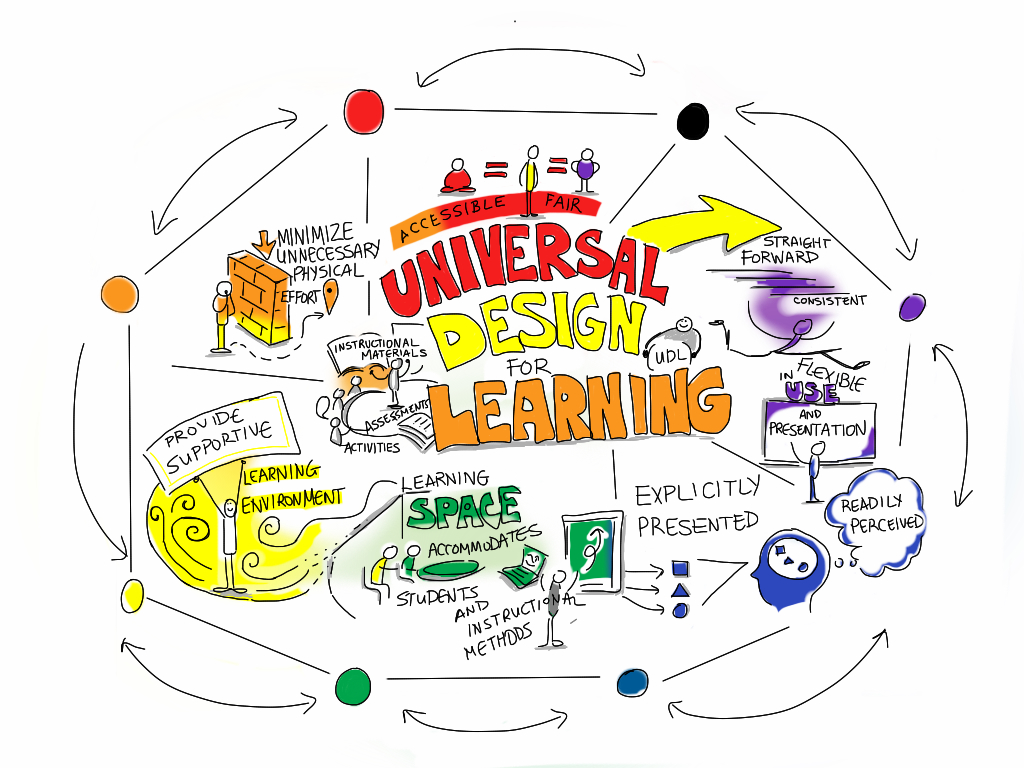Summary
This session focuses on the basics and best practices of universal design for learning in the online environment to help students access materials and participate. This session explores what universal design for learning is and why UDL practices should be used when planning and designing lessons and activities. UDL can help empower all students in the classroom while breaking down barriers. This session will focus on the key principles of UDL and provides a few best practices to get participants started in creating accessible online materials.
Essential Questions
What is Universal Design for Learning?
How can I apply the principles of UDL in the online environment?
Snapshot
Engage
Explore
Explain
Extend
Evaluate
Materials List
Computers with Internet access
Google Suite or Office Suite access
Presentation Slides (attached)
UDL Framework infographic (linked and attached; one per participant)
Universal Design Checklist (attached; one per participant)
Barriers Google Slides (attached, make a copy and share link with participants)
Learning Goals
Identify key factors of Universal Design for Learning in the online environment.
Apply this understanding of UDL to a chosen classroom activity.
Engage
12 Minute(s)
Display slide 2. Welcome participants and briefly introduce yourself and the professional development session.
Display slide 3. Briefly share the objectives for the session. This provides a road map of where you will go together during the session and lets participants know what to expect from the session.
Display slide 4. Ask participants to think about the idea of barriers and access and how it might apply to the classroom as they watch Dad Reinvents Playgrounds to be Accessible for All
After the video, explain to participants that there are often barriers in our education system and classrooms that prevent our students from accessing the learning and material we attempt to teach. Participants should keep these barriers in mind as they participate in the following activity.
After discussion of the responses to the activity with participants, share with them that there are obvious barriers to education for our students (slide 6). Some of those barriers are things that we as educators cannot control. But some of them are things that, like the playground creators, we can change if we reimagine the way our classrooms and our lessons are designed. Tell participants, “Universal Design for Learning—UDL—is about knocking down the bricks—the barriers—so that learning is accessible for all of the students in our classrooms.”
Explore
15 Minute(s)
Display slide 7 in attached Presentation Slides. After reading the directions on the slide, instruct participants to think about the barriers and keys for each image they will be viewing. Tell them to either discuss in a small group or to share out, depending on which option you have chosen for this section.
For each of the slides from 8–10, take time to discuss the barriers and keys participants notice in each image. If possible, track these barriers and keys for each image on a large piece of paper.
Display slide 8.
Possible Barriers:
notes presented only verbally?
no other ways to take notes other than on handout
not all students can see the board/notes/presentation
Possible Keys:
graphic organizers
chart on the wall
teacher in the back of the room
students grouped together
choice of annotation
Display slide 9.
Possible Barriers:
small/hard to see
do students know what everything means?
Possible Keys:
format for student expectations
Display slide 10.
Possible Barriers:
students need to know the routine/be taught the routine for this
format may be confusing
Possible Keys:
stations provide various opportunities to learn in different ways
extension activity options; would have clear directions
translation options
directions in multiple formats
Explain
30 Minute(s)
Show slide 11 to provide the definition of UDL.
Next, hand out the UDL Framework infographic to participants and show slide 12. Review the framework with participants.
Follow directions in slides 13–29, walking participants through each set of strategies. Consider modeling the how-to for participants on the screen. Provide ample time for participants to practice using the strategies specific to Google/Office suites.
Extend
10 Minute(s)
Display slide 30 and hand out the Universal Design Checklist to participants. Review the checklist with participants. Ask participants to reflect on one of the classroom activities discussed earlier and use the checklist to guide how they might make changes to the activity.
Evaluate
10 Minute(s)
Display slide 31. Ask participants to individually reflect on where they fall in the zones of comfort.
Are you in the comfort zone? You feel extremely good about implementing various kinds of strategies for your students.
Are you in the learning zone? It’s a little uncomfortable—it’s going to take some focused effort to make some changes.
Or are you feeling a little panicked? If you are in the panic zone, you might be feeling overwhelmed right now and not able to implement anything.
Think about what is causing your level of discomfort. Are there any barriers to your discomfort that could be removed or changed?”
Remind participants not to feel bad if they aren’t able to overhaul everything. These are stressful times so they need to give themselves some grace as they are learning to integrate UDL.
Display slide 32. Ask participants to participate in the Barriers and Keys activity from the beginning.
Resources
CAST. (2018). UDL guidelines, Version 2.2 [Graphic organizer]. http://udlguidelines.cast.org/more/downloads
DeMichele, S. (n.d.). Virtual station rotation. SlidesMania. https://slidesmania.com/virtual-station-rotations-template-created-by-stephanie-demichele/
Freethink. (2020, September 22). Dad Reinvents Playgrounds to be Accessible for All [Video]. YouTube. https://www.youtube.com/watch?v=Y3H3BxvDkCM&feature=youtu.be
K20 Center. (n.d.) Chalk talk. Strategies. https://learn.k20center.ou.edu/strategy/197
Iowa State University. (2019, September 12). Universal design checklist for your online course. Center for Excellence in Learning and Teaching. https://www.celt.iastate.edu/wp-content/uploads/2018/10/UDL-QM-accessibilitychecklist.pdf
Utah State University. (1999). Contrast checker. Center for Persons with Disabilities. https://webaim.org/resources/contrastchecker/


